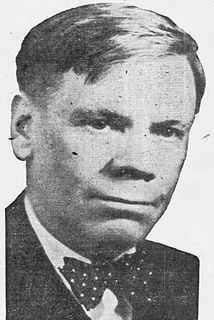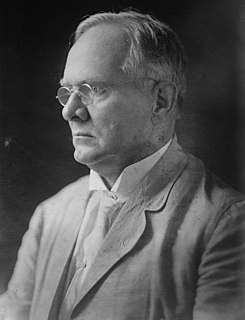
The 2004 Washington gubernatorial election on November 2, 2004 gained national attention for its legal twists and extremely close finish. In what was notable for being among the closest political races in United States election history, Republican Dino Rossi was declared the winner in the initial automated count and again in the subsequent automated recount. It wasn't until after the third count, a second recount done by hand, that Christine Gregoire, a Democrat, took the lead by a margin of 129 votes.
Elections to choose members of the North Carolina Council of State were held on Tuesday, November 2, 2004.

Rawghlie Clement Stanford was the fifth governor of Arizona and served from 1937 to 1939. He later served on the Arizona Supreme Court from 1943 until 1955, including 3 years as Chief Justice.

The 2008 United States Senate election in Minnesota took place on November 4, 2008. After a legal battle lasting over eight months, the Democratic–Farmer–Labor Party (DFL) candidate, Al Franken, defeated Republican incumbent Norm Coleman in one of the closest elections in the history of the Senate. Franken took his oath of office on July 7, 2009, more than half a year after the end of Coleman's term on January 3, 2009.

The 1954 New York state election was held on November 2, 1954, to elect the Governor, the Lieutenant Governor, the State Comptroller, the Attorney General, the Chief Judge and three associate judges of the New York Court of Appeals, as well as all members of the New York State Assembly and the New York State Senate.

The 2016 North Carolina gubernatorial election was held on November 8, 2016, to elect the Governor of North Carolina, concurrently with the 2016 U.S. presidential election, as well as elections to the United States Senate and elections to the United States House of Representatives and various state and local elections.

The 1911 Arizona gubernatorial election took place on December 12, 1911 for the post of the first elected Governor of Arizona. The Democratic nominee George W. P. Hunt defeated the Republican nominee Edmund W. Wells. Hunt and Wells were both members of the Constitutional Convention, Hunt being chosen President and leading the way for much of the drafting. Wells refused to sign the Constitution, considering aspects like the initiative, referendum, and especially judicial recall to be too radical.

The 1914 Arizona gubernatorial election took place on November 3, 1914 for the post of the Governor of Arizona. The Supreme Court of Arizona ruled that there would be no statewide elections in 1912, thus extending the terms to sync up with elections on even years. The Democratic nominee was incumbent governor George W. P. Hunt, his Republican opponent was the final Delegate to Congress from Arizona Territory, Ralph H. Cameron. Cameron was disadvantaged by the same reason the previous Republican nominee Wells was: he had opposed statehood with the present Constitution.

The 1918 Arizona gubernatorial election took place on November 5, 1918 for the post of the Governor of Arizona. Thomas Campbell, who served a partial term in 1917 and had his election overturned by the Supreme Court of Arizona, returned to contest the Governors office. Incumbent Governor Hunt declined to run again after the stress of the close elections and the year-long court battle. Despite falling to its lowest percentage in years, the sole third party challenger held the difference between the two candidates. The Democratic challenger was state senator Fred T. Colter, a pro-Hunt Democrat.

The 1922 Arizona gubernatorial election took place on November 7, 1922. George W. P. Hunt was Arizona's first governor, after retiring in 1919 he served as Ambassador to Siam during the tail end of the Wilson administration. After being dismissed by Harding, Hunt returned to Arizona and decided to contest his old seat. Both Hunt and Campbell faced off in 1916, the closest gubernatorial in Arizona history. This election was the highest percentage of votes Hunt ever got in his 7 gubernatorial races.

The 1924 Arizona gubernatorial election took place on November 4, 1924. Despite being a Republican year nationally, President Coolidge's election in Arizona was rather close. He only took Arizona with 40% of the vote against Davis' 35% and La Follette's 23%. The closest Arizona gubernatorial election since 1916, Hunt's lead in votes would continue to decline.

The 1926 Arizona gubernatorial election took place on November 2, 1926. Despite being a Democratic year generally, Hunt barely managed to be re-elected against his Republican opponent Elias Clark. Hunt had been governor for around 11 out of the State of Arizona's 14 years, coupled with his age and with issues regarding the Colorado River Compact, he was running out of steam. Despite that Hunt narrowly prevailed and won.

The 1928 Arizona gubernatorial election took place on November 6, 1928. Despite a fairly poor economy, a 15-point loss by Al Smith for the Arizona electoral votes, and having served for nearly 6 full terms, Hunt only narrowly lost the general election. Other state Democrats like Senator Ashurst and Representative Douglas both won re-election. John C. Phillips became the second Republican to serve as Arizona Governor, and the first to beat Hunt in a general election.

The 1916 Florida Gubernatorial Election was held on November 7, 1916 to determine the Governor for the State of Florida. Democratic incumbent Governor Park Trammell was term-limited and could not run for re-election.

The 1930 Arizona gubernatorial election took place on November 4, 1930. George W. P. Hunt narrowly won the general election in 1930, defeating incumbent governor John Calhoun Phillips, who had defeated Hunt in his bid for reelection in the previous election year in 1928.

The 1932 Arizona gubernatorial election took place on November 8, 1932. Incumbent Governor George W. P. Hunt ran for the Democratic nomination, but lost in the primary to Benjamin Baker Moeur, whose pre-gubernatorial experience included service as the Secretary of the Board of Education for Arizona State Teacher's College, which would later become Arizona State University.

The 1934 Arizona gubernatorial election took place on November 6, 1934. Incumbent Governor Benjamin Baker Moeur ran for reelection, he was challenged by former governor George W. P. Hunt and future Governor Rawghlie Clement Stanford in the Democratic primary, but he defeated both of them by a comfortable margin.

The 1936 Arizona gubernatorial election took place on November 3, 1936. Incumbent Governor Benjamin Baker Moeur ran for reelection, but he was defeated in the Democratic primary by former judge of the Maricopa County Superior Court Rawghlie Clement Stanford.

The 1970 Arizona gubernatorial election took place on November 3, 1970. Incumbent Governor Jack Williams ran for reelection to a third term as Governor. United States Ambassador to Bolivia Raúl Héctor Castro won the Democratic nomination, and narrowly lost the general election to Williams by 1.78%. Williams was sworn into his third and final term as Governor on January 5, 1971.













